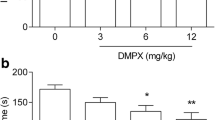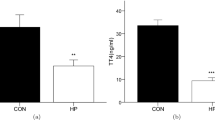Abstract
Triiodothyroacetic acid (TA3) is a natural thyroid analogue which possesses some of the properties of triiodothyronine (T3). In particular, it has an inhibitory effect on the thyreotropic axis, but its peripheral effects are reduced. Given the activity of T3 on psychopharmacological models of depression in rodents, we investigated the effects of TA3 on some pharmacological and behavioral tests in mice. TA3 antagonized apomorphine- and oxotremorine-induced hypothermia, potentiated yohimbine-induced toxicity andl-5-hydroxy-tryptophan-induced head twitches, but did not affect forced swimming-induced immobility or reserpine-induced hypothermia. Thus, TA3 was effective on the same psychopharmacological tests which have previously been used to demonstrate the antidepressant-like effects of T3. Moreover, TA3 under the same experimental conditions as T3 has little effect on the metabolic clearance rate parameters, and might, therefore, be preferable to T3 for clinical use in depression.
Similar content being viewed by others
References
Atterwill CK (1981) Effect of acute and chronic tri-iodothyronine (T3) administration to rats on central 5-HT and dopamine-mediated behavioural responses and related brain biochemistry. Neuropharmacology 20:131–144
Atterwill CK, Bunn SJ, Atkinson DJ, Smith SL, Heal DJ (1984) Effects of thyroid status on presynaptic alpha 2 adrenoceptor function and beta adrenoceptor binding in the cat brain. J Neural Transm 59:43–55
Boissier JR, Simon P (1965) Action de la caféine sur la motilité spontanée de la Souris. Arch Int Pharmacodyn Ther 158:212–221
Bourin M, Poncelet M, Chermat R, Simon P (1983) The value of the reserpine test in psychopharmacology. Arzneimittelfor-schung 33:1173–1176
Brochet D, Puech AJ, Simon P (1982) Liothyronine (T3), antidepressants and hypersensitivity of beta-adrenergic receptors. 13th CINP Congress, June 20–25, Jerusalem, Abstract p 79
Brochet D, Martin P, Soubrié P, Simon P (1985b) Effects of triiodothyronine on the hydroxytryptophan-induced head twitch and its potentiation by antidepressants in mice. Eur J Pharmacol 112:411–414
Clur A (1985) Iodothyronines and iodotyronines as hypothetical receptors for catecholamines and opiates. Medical Hypotheses 16:97–131
Corne SJ, Pickering RW, Warne BT (1963) A method for assessing the effect of drugs on the central action of 5-hydroxytryptamine. Br J Pharmacol 20:106–120
De Groote LJ, Refetoff S, Bernal J, Rue PA, Czleoni AH (1978) Nuclear receptors for thyroid hormone. J Endocrinol Invest 1:79–88
Emlen W, Segal DS, Mandell AJ (1972) Thyroid state effects on pre- and postsynaptic central noradrenergic mechanisms. Science 175:79–82
Engstrom G, Svensson TH, Waldeck B (1974) Thyroxine and brain catecholamines: increased transmitter synthesis and increased receptor sensitivity. Brain Res 77:471–483
Fox AW, Juberg EN, May JM, Johnson RD, Abel PW, Minneman KP (1985) Thyroid state and adrenergic receptor subtypes in the rat: comparison of receptor density and responsiveness. J Pharmacol Exp Ther 235:715–723
Friedman E, Cooper TB, Dallob A (1983) Effects of chronic antidepressant treatment on serotonin receptor activity in mice. Eur J Pharmacol 89:69–76
Gitlin MJ (1986)l-Triiodothyronine-precipitated angina and clinical response. Biol Psychiatry 21:543–545
Goodwin GM, Green AR, Johnson P (1984) 5-HT2 receptor characteristics in frontal cortex and 5-HT2 receptor-mediated head-twitch behaviour following antidepressant treatment to mice. Br J Pharmacol 83:235–242
Green AR, Heal DJ, Johnson P, Laurence BE, Nimgaonkar VL (1983) Antidepressant treatments: effects in rodents on dose-response curves of 5-hydroxytryptamine-and dopamine-mediated behaviors and 5-HT2 receptor number in frontal cortex. Br J Pharmacol 80:377–385
Greenberg CM, Blank B, Pfeiffer FR, Paul JF (1973) Relative activities of several 3′ and 3′5′ alkyl and aryl thyromimetic agents. Am J Physiol 305:821–826
Handley SL, Singh L (1986) The modulation of head-twitch behavior by drug acting on beta-adrenoceptors: evidence for the involvement of both beta1- and beta 2-adrenoceptors. Psychopharmacology 88:320–324
Irwin S (1968) Comprehensive observational assessment: Ia. A systematic quantitative procedure for assessing the behavioral and physiologic state of the mouse. Psychopharmacologia 13:222–257
Malick JB (1983) Potentiation of yohimbine-induced lethality in mice: Predictor of antidepressant potential. Drug Dev Res 3:357–363
Martin P, Brochet D, Soubrié P, Simon P (1985a) Triiodothyro-nine-induced reversal of learned helplessness in rats. Biol Psychiatry 20:1023–1025
Martin P, Francès H, Simon P (1985b) Dissociation of head twitches and tremors during the study of interactions with 5-hydroxytryptophan in mice. J Pharmacol Methods 13:193–200
Martin P, Soubrié P, Simon P (1986) Comparative study of the effects of stimulation or blockade of beta-adrenoceptors on the head-twitches induced in mice by 5-hydroxytryptophan versus 5-methoxy-dimethyltryptamine. J Pharmacol (Paris) 17:119–125
Massol J, Humbert P, Semon C, Grandmottet-Cambefort C, Leostic D, Bechtel P, Badet JM (1985) Carcinomes différenciés de la thyroide. Traitement suppressif par l'acide triiodothyroacétique associé aux hormones thyroidiennes. In: Gandon J, Leroux R (eds) Cancers du corps thyroide. Masson, Paris, pp 193–200
Massol J, Martin P, Soubrié, Simon P (1987) Triiodothytoacetic and induced reversal of learned helplessness in rats. Eur J Pharmacol 134:345–348
Meyer T, Hesch RD (1983) Triiodothyronamine: a beta-adrenergic metabolite of triiodothyronine? Horm Metab Res 15:602–606
Nimgaonkar VL, Green AR, Cowen PJ, Heal DJ, Graham-Smith DG, Deakin JFW (1983) Studies on the mechanisms by which clenbuterol, a beta-adrenoceptor agonists, enhances 5-HT-mediated behaviour and increases metabolism of 5-HT in the brain of the rat. Neuropharmacology 22:739–749
Ogren SO, Fuxe K, Agnati LF, Gustafsson JA, Jonsson G, Holm AL (1979) Reevaluation of the indoleamine hypothesis of depression. Evidence for a reduction of functional activity of central 5-HT systems by antidepressant drugs. J Neural Transm 46:85–103
Olssen EGJ, Symons C, Hawkey PD (1980) Effect of triac and beta-blockade on the myocardium of developing rats. Congrès Européen de Cardiologie Paris 22–26 juin 1980, Abstr. No 554
Peroutka SJ, Snyder SH (1980) Long-term antidepressant treatment decreases spiroperidol-labelled serotonin receptor binding. Science 210:88–90
Porsolt RD, Bertin A, Jalfre M (1977) “Behavioural despair” in mice: a primary screening test for antidepressants. Arch Int Pharmacodyn Ther 229:327–336
Porsolt RD, Bertin A, Jalfre M (1978) “Behavioural despair” in rats and mice: strain differences and the effects of imipramine. Eur J Pharmacol 51:291–294
Porsolt RD, Bertin A, Blavet N, Deniel M, Jalfre M (1979) Immobility induced by forced swimming in rats: Effects of agents which modify central catecholamine and serotonin activity. Eur J Pharmacol 57:201–210
Prange AJ (1985) Psychotropic drugs and the thyroid axis: a review of interactions. In: Kemali O, Racagni G (eds) Chronic treatments in neuropsychiatry. Raven Press, New York, pp 103–110
Puech AJ, Chermat R, Poncelet M, Doaré L, Simon P (1981) Antagonism of hypothermia and behavioral response to apomorphine: A simple, rapid and discriminating test for screening antidepressants and neuroleptics. Psychopharmacology 75:84–91
Puymirat J (1985) Effects of dysthyroidism on central catecholaminergic neurons. Neurochem Int 7:969–977
Quinton RM (1963) The increase in the toxicity induced by imipramine and other drugs in mice. Br J Pharmacol 21:51–66
Ross SB (1980) Antagonism of reserpine-induced hypothermia in mice by some beta-adrenoceptor agonists. Acta Pharmacol Toxicol 47:347–350
Rubin R, Malone MH, Waugh MH, Burke JC (1957) Bioassay of rauwolfia roots and alkaloids. J Pharmacol Exp Ther 120:125–136
Schechter H, Chance RD (1979) Non specificity of “behavioral despair” as an animal model of depression. Eur J Pharmacol 60:139–142
Schwartz JC, Costentin J, Martres MP, Protais P, Baudry M (1978) Modulation of receptor mechanisms in the CNS: hyper- and hyposensitivity to catecholamines. Neuropharmacology 17:665–685
Shapiro S, Salas M, Vukovich K (1970) Hormonal effects on autogeny of swimming ability in the rat. Assessment of central nervous system development. Science 168:147–150
Simon P, Lwoff JM (1968) Critères de sélection des antidépresseurs. In: The Present Status of Psychotropic Drugs (Proceedings of the 6th CINP Congress, April 20–26, Tarragona). Excerpta Medica International Congress Series, N 180, pp 184–195
Singhal RL, Hadina PD, Pastogi (1975) Brain biogenic amines and alteres thyroid function. Life Sci 17:1617–1624
Strombom U, Svensson TH, Jackson DM, Ergstrom G (1977) Hyperthyroidism: specifically increased response to central NA-(β)-receptor stimulation and generally increased monoamine turnover in brain. J Neural Transm 41:73–92
Stolz JF, Marsen CA, Middlemiss (1983) Effect of chronic antidepressant treatment and subsequent withdrawal on 3H-5-hydroxytryptamine and 3H-spiperone binding in rat frontal cortex and serotonin receptor mediated behaviour. Psychopharmacology 80:150–155
Vaccari (1982) Decreased central serotonin function in hypothyroidism. Eur J Pharmacol 82:93–95
Author information
Authors and Affiliations
Rights and permissions
About this article
Cite this article
Massol, J., Martin, P., Brochet, D. et al. Antidepressant-like effects of triiodothyroacetic acid in mice. Psychopharmacology 94, 97–102 (1988). https://doi.org/10.1007/BF00735888
Received:
Revised:
Issue Date:
DOI: https://doi.org/10.1007/BF00735888




